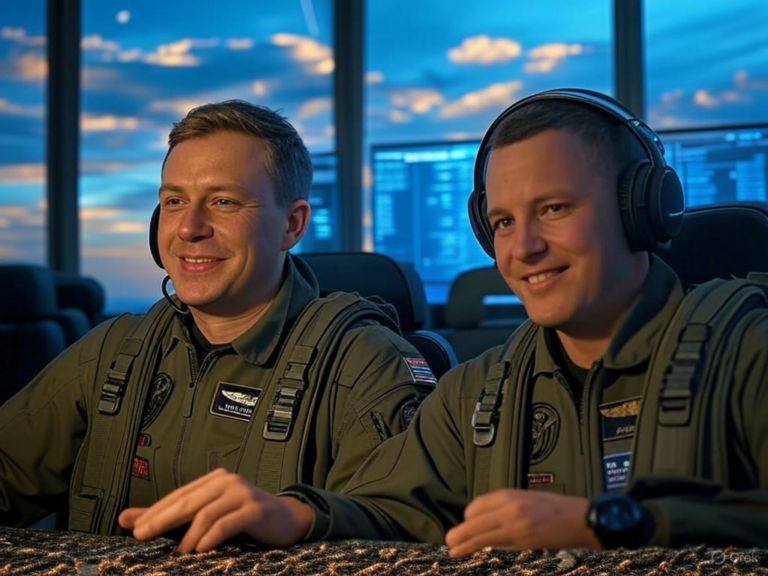
Military AI Market Forecasted to Reach $15.62 Billion by 2029
Overview of the Military AI Market Growth
The military AI market is experiencing explosive growth, projected to climb from $6.58 billion in 2022 to an impressive $15.62 billion by 2029. This surge reflects a compound annual growth rate (CAGR) of 13.1%, highlighting how artificial intelligence is transforming defense strategies worldwide. Have you ever considered how AI could redefine battlefield operations, making them faster and more precise?
Driven by rapid technological advancements and increasing global defense budgets, the military AI market is at the forefront of innovation. For example, AI-powered systems are now helping militaries process vast amounts of data in real time, turning raw information into actionable insights. This evolution isn’t just about numbers; it’s about enhancing human capabilities and ensuring safer, more efficient missions.
As nations prioritize modernization, investments in AI are skyrocketing. A study from Stratview Research found that this market’s expansion is fueled by the need for automation in high-stakes environments, where every second counts. What if we could use AI to predict threats before they emerge, potentially saving lives?
Key Drivers Shaping the Military AI Market
In the thriving military AI market, several factors are accelerating this upward trajectory. Automation stands out as a game-changer, enabling forces to deploy AI in autonomous weapons and drones that handle complex tasks with minimal human intervention. This not only boosts efficiency but also minimizes risks to personnel on the ground.
Another major driver is data-driven decision-making, where AI harnesses machine learning and predictive analytics to deliver real-time battlefield intelligence. Imagine a scenario where troops receive instant alerts about enemy movements, all thanks to AI algorithms analyzing satellite feeds. Cybersecurity is also critical, with AI tools fortifying defense networks against sophisticated digital attacks that could otherwise cripple operations.
Modernization efforts by leading countries like the US, China, and India are pushing the military AI market forward, with billions poured into research and development. Cloud computing plays a supporting role, providing the infrastructure needed for advanced AI applications. These drivers collectively create a dynamic environment where innovation thrives, but they also raise questions: How can we balance technological progress with ethical responsibilities?
Market Segmentation and Top Growth Areas
The military AI market breaks down into key segments like offerings, technology, platforms, applications, and regions, each offering unique opportunities for expansion. Understanding these segments helps stakeholders identify where to invest for maximum impact. For instance, hardware components are essential for building the backbone of AI systems.
Growth in Military AI Market Offerings
Hardware in the military AI market includes critical elements like sensors, processors, and GPUs that power autonomous systems. These components are vital for real-time processing in harsh environments, such as desert operations or naval missions. Software solutions, on the other hand, focus on predictive analytics and automated decision-making, helping commanders make swift, informed choices.
Services round out this segment, offering integration and training to ensure smooth AI adoption. A relatable example: Think of services as the bridge that connects cutting-edge tech to everyday military use, like training soldiers on AI interfaces. This area is growing rapidly, as demand for customized AI solutions rises.
Key Technologies in the Military AI Market
Machine learning and deep learning are at the core of the military AI market’s technological advancements, enabling systems to learn from data and improve over time. Advanced computing and simulation allow for realistic training scenarios, while neural networks mimic human brain functions for complex pattern recognition. These technologies are evolving quickly, with applications in everything from weapon targeting to strategic planning.
By incorporating these innovations, militaries can gain a competitive edge. For example, neural networks could analyze weather patterns to optimize drone flights, showcasing the practical value of this segment.
Emerging Platforms in the Military AI Market
Platforms span land-based systems, airborne platforms, naval applications, and the rapidly expanding space segment. The space area, including AI-enabled satellites and CubeSats, is the fastest-growing, driven by needs in communication and intelligence gathering. Picture a network of satellites using AI to detect missile launches in real time—it’s not science fiction anymore.
These platforms are interconnected, creating a web of capabilities that enhance overall defense readiness. As the military AI market evolves, investing in space-based tech could be a smart move for future dominance.
Applications Driving the Military AI Market
Applications like intelligence, surveillance, and reconnaissance (ISR) are transforming how militaries operate, using AI for detailed monitoring and threat detection. Logistics and supply chain optimization streamline operations, ensuring resources reach the front lines efficiently. Battlespace awareness and predictive threat analysis provide foresight, while combat training and simulation offer safe, effective preparation.
Cybersecurity operations round out the list, protecting against digital incursions. Here’s a tip: Businesses in this space should focus on ISR for high returns, as it’s a cornerstone of modern defense strategies.
Trends and Innovations Shaping the Landscape
In the military AI market, trends like autonomous systems are revolutionizing warfare, with drones and robotic vehicles handling navigation and targeting autonomously. Human-machine teaming is another highlight, where AI assists human operators to reduce errors and cognitive load. This synergy could be the key to more effective missions—imagine a pilot using AI suggestions to evade threats mid-flight.
AI-enhanced cyber defense uses automated systems for anomaly detection, staying ahead of hackers. Edge computing brings processing power closer to the action, cutting down on delays, and space-based AI is opening new frontiers for surveillance. These innovations aren’t just trends; they’re reshaping how we think about security. What innovations do you see on the horizon for the military AI market?
Regional Insights and Market Leaders
North America leads the military AI market, thanks to heavy US investments in robotics and AI integration. Europe and Asia-Pacific are close behind, with China and India accelerating their modernization efforts. For instance, China’s focus on AI research is narrowing the gap with Western powers, creating a more competitive global landscape.
This regional dynamic offers opportunities for collaboration, like joint ventures between US and European firms. As the military AI market grows, keeping an eye on these areas could help investors spot emerging leaders.
Opportunities and Competitive Landscape
The military AI market is ripe with opportunities for technology providers, from developing AI chipsets to advanced sensors. Systems integrators can customize solutions for specific needs, while government partnerships foster innovation through shared resources. A hypothetical scenario: A startup partners with a defense agency to create AI for disaster response, blending commercial and military tech.
Actionable advice: If you’re in this field, seek collaborations to navigate regulatory hurdles and accelerate development. The competitive edge goes to those who innovate ethically and efficiently.
Challenges and Ethical Considerations
Despite its potential, the military AI market faces challenges like ethical dilemmas with autonomous weapons, which raise questions about accountability and civilian safety. Lack of standardization complicates integration between forces, and policy restrictions can limit access to key technologies. For example, export controls might hinder international collaborations, slowing progress.
Addressing these issues requires proactive measures, such as developing global standards. How can we ensure that advancements in the military AI market prioritize human rights?
Outlook: The Road to 2029 and Beyond
Looking ahead, the military AI market is poised for continued growth, with AI-driven decision-making and automation leading the charge. By 2029, we could see new alliances forming as nations vie for AI superiority. This evolution will not only enhance defense capabilities but also influence global security dynamics.
Staying informed is crucial—consider exploring AI ethics or investing in related tech. The future is bright, but it demands careful navigation.
Frequently Asked Questions
What is driving the rapid growth of the military AI market?
Automation, real-time data analysis, and defense modernization are key drivers, with global investments fueling the surge. According to a report from Stratview Research, these factors are pushing the market toward its $15.62 billion projection.
Which regions are leading in military AI adoption?
North America dominates, but Asia-Pacific is gaining ground quickly. Countries like China are investing heavily, making this a hot spot in the military AI market.
What are the biggest challenges in the military AI market?
Ethical concerns, interoperability issues, and cybersecurity risks top the list, requiring balanced approaches to sustain growth.
Conclusion
As the military AI market heads toward $15.62 billion by 2029, its impact on global defense is undeniable. From enhancing operations to sparking ethical debates, AI is a force for change. We encourage you to share your thoughts in the comments below or explore more on our site—how might this technology shape your world?
References
- Stratview Research. “Artificial Intelligence in Military Market.” https://www.stratviewresearch.com/3277/artificial-intelligence-in-military-market.html
- OpenPR. “Artificial Intelligence in Military Market is Forecasted.” https://www.openpr.com/news/3987565/artificial-intelligence-in-military-market-is-forecasted
- Knowledge Sourcing Intelligence. “AI in Defense Market.” https://www.knowledge-sourcing.com/report/ai-in-defense-market
- Technavio. “Aerospace Artificial Intelligence Market.” https://www.technavio.com/report/aerospace-artificial-intelligence-market-industry-analysis
- MarketsandMarkets. “Military Robots Market.” https://www.marketsandmarkets.com/Market-Reports/military-robots-market-245516013.html
- EIN Presswire. “AI in Military Market Size.” https://www.einpresswire.com/article/776104172/ai-in-military-market-size-at-usd-14-39-billion-at-cagr-of-11-99-due-to-increased-ai-powered-technologies-worldwide
- YouTube. “Video on AI in Military.” https://www.youtube.com/watch?v=xJA6O397FCo
- Maximize Market Research. “Artificial Intelligence and Robotics in Aerospace and Defense Market.” https://www.maximizemarketresearch.com/market-report/artificial-intelligence-and-robotics-in-aerospace-and-defense-market/183933/
military AI market, artificial intelligence in defense, AI military trends, military AI forecast, AI defense applications, military AI growth, AI in military technology, defense AI innovations, global military AI, AI market projections







